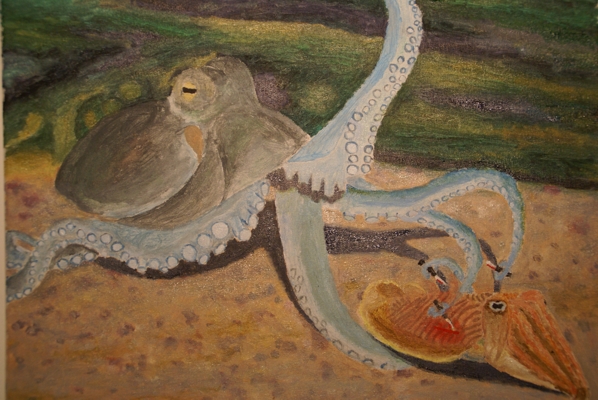Nicolaas VroomIs it water or gas? |
Back
|

|
Is it water or gas?
|
Acryl and Oil on canvas 80 by 30 cm |
The above shows a picture of an octopus and a cuttlefish. The octopus has is depicted with 3 knives in his tentacles. The idea behind the picture is that the octopus is a chirurg who is going to operate the cuttlefish. When you look carefull the cuttlefish has a small wound on his back. This small wound is surrounded by a cloud of blood.
This cloud of blood is the reason for the name of this painting: Is it water or gas?
From the view point of us humans: it is water, because we are capable to distinquish between the two phenomena water and gas.
From the view point of any fish who lives in water: it is gas, because in the world of a fish there exist no water. In some sense flies a fish (like a bird) in the air. The blood, which escapes from the cuttlefish is much more like a gas. What a fish can is distinquish based on its color, between are different types of gas. Blood is a red gas and ink is a dark blue gas.
Behind this painting is a much deeper physical meaning. We humans can observe each other with our eyes and senses. Using our senses we can distinquish between water and gas. Fishes don't know this difference. As such they are wrong and all is more difficult. The world is more complex as they think.
However we humans also can make mistakes if we only use our senses and the measurements we take.
To observe each other and the world surrounding us we use light( and other forms of radiation). This is done by transforming light (in the form of photons) that reach our eyes into an electrical signal and to transform that again in our brain into a 3D picture. The photons that reach our eyes have an origin and follow a certain trajectory. This raises the sugestion that there are only photons in these trajectories because those are the photons we observe. The reality is that the whole space surrounding us is filled with photons which all move in different directions and which we never will observe. The same can be said for all forms of radiation. Only a small number will reach us. In other words space surrounding us is not empty.
But there are more cases where we humans can make mistakes. We observe with our eyes and in some sense only the outside of individual objects. We can not see what happens inside and only guess. How smaller the details we want to observe and how more accurate, the more difficult.
Wat we want in general is to understand the reality. We want to know what is the same, what are the differences and if there are differences what the cause is. The problem is that if you want to understand these differences you must do that from the perspectif of the objects among themselves you want to understand and leave humans completely outside consideration.
An example is the movement of the stars in our galaxy the Milkyway, or closer to home the movement of the planets aound the Sun. The issue is the movement among themselves.
A special case is a black hole. A black hole is a collapsed star, an object with a small radius and a large density. Compared with our Sun, in certain cases a blackhole is slightly heavier than our Sun and in some cases like in the center of our Milkyway very much heavier. A black hole is for sure no hole and no singularity. An important difference with a star is that a black hole does not emit light (photons) and if it does it is captured immediate. That means we humans cannot observe a blackhole using visible light.
From the other side we can predict that there is something at the same way that planets move around the Sun, because ther are also stars which move around a black hole. In other words, the physical behaviour is the same. The scale, the distances involved and the masses are different.
If we want to describe the behaviour among objects among themselves than we have to study how these objects 'observe' and influence each other. That is with the aid the force of gravitation and specific with gravitons. In this case light or photons are not involved.
Electromagnetic phenomena can be neglected. If you want to know the laws involved the same thing happens.
A different problem is how we measure the position of the objects involved. This is done with light and depents about the place where these observations are performed and about the speed of light.
Physical phenomena have to be understood and described from within there own point of view and within there own world. That is also true if these phenomena slowly change globaly. At the root of these changes lies a physical cause. The same is true for the laws that describe these phenomena.
This is the end of the story behind the painting "Is it water or gas?". But the full story has not ended.